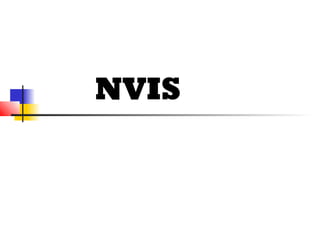
Nvis
- 1. NVIS
- 2. NVIS What is NVIS ? Means Near-Vertical Incidence Skywave Opposite of DX (long – distance) Local - to - Medium Distance (0 – 250 mls)
- 3. ‘Ordinary’ Propagation Illustration courtesy of Barrett Communications Pty
- 4. ‘Ordinary’ Propagation To travel a long distance, the signal must take off at a LOW angle from the antenna – 30 degrees or less This is so that it can travel the maximum distance before it first arrives at the Ionosphere Long gap before signal returns to earth – the part in between this and the end of the ground wave is the so-called Skip (or Dead) Zone
- 5. ‘Ordinary’ Propagation Illustration courtesy of Barrett Communications Pty
- 6. NVIS Propagation Illustration courtesy of Barrett Communications Pty
- 7. NVIS Propagation To travel a local - medium distance, the signal must take off at a HIGH angle from the antenna – typically 60 – 90 degrees This returns from the Ionosphere at a similar angle, covering 0 – 250 mls It thus fills in the Skip (or Dead) Zone – like taking a hose and spraying it into an umbrella !
- 8. NVIS Propagation Illustration courtesy of Barrett Communications Pty
- 9. Using NVIS successfully HIGH angle of radiation from antenna Minimise ground wave, as it will interfere with the returning skywave Most importantly, CHOOSE THE CORRECT FREQUENCY BAND – go too high in frequency and your signal will pass through straight into space!
- 10. Choosing the right frequency The Ionosphere – D, E, F1 & F2 layers D and to a lesser extent, E layers attenuate and absorb signal Best returns from F2 layer At any one time we need to know the frequency of the F2 layer – The Critical Frequency or foF2 Optimum frequency for NVIS work around 10% below this
- 11. The Ionosphere Illustration courtesy of the University of Ulster Communications Centre
- 12. NVIS - Frequency and Time ‘Higher’ frequency band during day, ‘Middle’ frequencies afternoon/evening, ‘Lower’ frequencies at night Frequencies also affected by time of year and period of sunspot cycle For best results, three different frequency ‘bands’ are required
- 13. NVIS – The Antenna Side Need high angle (60-90°) radiation for NVIS Vertical no use – predominantly low angle Half wave dipole at ‘text book’ height – 0.5 wavelength produces low angle radiation, BUT, if lowered to 0.25 wavelength or below, produces high angle radiation ! Not too low, though – some earth losses. A reflector wire or earth mat can reduce this
- 14. ‘Tone’ Burst’s View of NVIS RSGB Radio Today Sept 2000
- 15. Questions?
